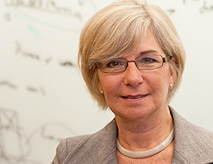 Goldstein's Pride:
The world’s largest collection of genetically indexed clinical specimens of some of the planet’s most persistent bacterial pathogens.
Goldstein's Pride:
The world’s largest collection of genetically indexed clinical specimens of some of the planet’s most persistent bacterial pathogens.
Photos by
Vernon Doucette
“I’d clean it if I had the time,” says Goldstein, a School of Medicine professor of pediatrics, who specializes in infectious diseases and whose expressive eyes, silver mane, and jowls bring to mind the actor Bert Lahr, of Cowardly Lion fame. The office flotsam is the result of the lab’s move, Goldstein explains, as he lurches to extinguish the sounds of an atonal composition from a classical radio station. But the move, from the gothic quarters of the Maxwell Finland Laboratory on Albany Street, was made five years ago.
Any assumptions that Goldstein’s dishevelment extends to his work area dissolve when the scientist opens a door to his lab, revealing proof of an ardently compulsive mind. Here, in a series of end-to-end industrial-size deep freezers, is Goldstein’s pride, inspiration, and obsession: the world’s largest collection of genetically indexed clinical specimens of some of the planet’s most persistent bacterial pathogens. The biggest of these — nearly 1,000 isolates — is of Streptococcus pneumoniae (a.k.a. pneumococcus), a common microbe that each year causes deadly meningitis in millions of vulnerable people, mainly children. The startling adaptability and human toll of this bacterium, which lives harmlessly in the noses of most humans, have consumed Goldstein’s forty-year career.
Responsible for the deaths of more than a million children each year and with the single vaccine against it only partly effective, pneumococcus is the white whale to Goldstein’s inner Ahab. The current vaccine, Prevnar, based on the chemistry of the bacterium’s capsule, or coating, works on just seven of ninety-one known pneumococcal strains. Relentlessly, and sometimes at his own expense, Goldstein has been blazing a scientifically novel path to a better vaccine, and his out-of-the-box approach may lead to vaccines for other menacing bacteria as well. His strategy will have consumed years of genetic testing and retesting until — and Goldstein is on the cusp of this — he hones in on a vaccine that will stop all strains of Streptococcus pneumoniae in their tracks.
To do that, he needs to isolate the DNA that is both common to all strains and resistant to mutation. The common proteins expressed by these unvarying genes will, he hopes, trick the body into thinking that it is being attacked and tell the immune system to create antibodies that will go to war with every strain of the bacterium.
Goldstein expects that search to take three years or more. When it’s done, however, he’ll be on the home stretch and can turn to well-established protocols for vaccine development, including cloning and animal testing.
 Ten Years In
Ten Years In MED’s Richard Goldstein has spent a decade constructing the evolutionary tree of Streptococcus pneumoniae. The complete model is probably three years away.
Charles Darwin Was Here
“The healthy high school football star who suddenly dies of meningitis — that’s most likely Streptococcus pneumoniae,” says Goldstein, who was recently awarded a three-year, $300,000 research grant from the Hartwell Foundation, which selects ten “exceptional individuals” annually and funds “innovative, cutting-edge biomedical applied research” that advances children’s health.
If grants for innovation had existed in the nineteenth century, one would likely have been awarded to Goldstein’s idol, Charles Darwin. Among the charts and graphs in his presentation at a recent conference of molecular biologists in Tel Aviv, Goldstein included a portrait of his prolific muse. “Everything I’m saying now was said by Darwin in 1859,” he says. He owns thirteen first editions of Darwin’s books — his “pride and joy.” Darwin penned forty volumes, and “they didn’t all come from going to Galapagos,” Goldstein says. “They came from him looking out the window of his study. He wrote a whole book on domestic ants.” Just as these seemingly prosaic creatures riveted the father of the theory of evolution, Goldstein finds provocation in the familiar.
According to the federal Centers for Disease Control and Prevention, most people have been pneumococcus carriers at some point in their lives, although the bacterium is most common in young children. Mostly harmless, it’s an exclusively human pathogen that can viably ride a sneeze six feet from one nose to another. Occasionally it spreads to other body parts, causing ear infections, sinusitis, and lung infections. Worse, it can get into places in the body that are normally free of bacteria, including the blood, or infect the lining of the brain and the spinal cord, causing meningitis. Pneumococcus is the most common cause of bacterial meningitis, contagious pneumonia, and ear infections worldwide.
 Dangerous Strains
Dangerous Strains Goldstein believes the bacterium’s extraordinary virulence stems from its vast evolutionary diversity.
While pneumococcus is not always deadly, it is always a stubborn adversary. The first penicillin-resistant pneumococcal bacteria were discovered in the 1960s. Since then, strains have emerged that are resistant to other, more costly antibiotics. A highly effective vaccine — a preparation that resembles the bacterium closely enough to rally the body’s defenses, or antibodies, but not actually infect it — makes more scientific and economic sense than playing catch-up with improved antibiotics.
Question one for Goldstein is why pneumococcus makes some people sick and not others. He believes the bacterium’s feisty virulence is a result of its vast evolutionary diversity. How then to fashion a vaccine that keeps pace with pneumococcus’s mutation rate so as not to require the development of new, modified — and perhaps prohibitively costly — vaccines? The answer, he believes, is to make one vaccine that fits all pneumococcus mutations, past, present, and future.
“My vaccine will be much less expensive because it won’t be based on the capsule,” says Goldstein, who has published papers in the New England Journal of Medicine, Nature, and many other leading journals. “They’ll never make a ninety-one-variant vaccine because it’s expensive and time-consuming. So, how to get around it? That’s my Hartwell proposal.”
Derived from the complex sugars that form the bacteria’s capsule, the existing vaccine was developed in the 1990s by Goldstein’s longtime mentor and friend Porter Anderson, then a professor at Harvard Medical School. Modest and soft-spoken, Anderson is a hero to many in the infectious disease world for his development, in the late 1960s, of the now routinely administered Hib, or Haemophilus influenzae type b vaccine, which has nearly obliterated the disease in the United States.
“I’ve known Richard since 1974 or 1975, when he was an assistant professor at Harvard Medical School and so was I,” recalls Anderson, who is officially retired but volunteers much of his time at Children’s Hospital Boston. “He is bright and industrious and energetic. The work he does requires a great deal of data generation and analysis, and he goes at it tooth and nail. He has painted a pretty complete picture of the different pneumococcus strains using sophisticated techniques that I never try to do, and appreciate.”
“It all goes back to the tree,” Goldstein says, gesturing toward a chart that looks nothing like a tree, but more like a vertical bar code. In Goldstein’s world, the foundation for any antibacteria vaccine is the microbe’s evolutionary tree, which uses DNA-mapping technology to display concentrations of mutant genes, and the “cold spots” — appearing as sparse areas on the otherwise dense bar code — where genes appear to resist alteration.
“The simplest and undeniable conclusion from my perspective as an evolutionary biologist, as well as a microbial population biologist,” Goldstein says, is that for a vaccine to be absolutely effective against Streptococcus pneumoniae, it will have to be based not on the bacterium’s capsule, which is constructed of complex sugars, but on a common protein that is conserved across the complete evolutionary cast of pneumococcus. “This,” he says, “is the reason for my seemingly unending efforts to acquire isolates, phylogenically characterize each, and build the ever-growing tree until it reflects the actual diversity of the species.”
Goldstein has successfully built trees for several pathogenic bacteria, including the strain of E. coli that causes urinary tract infections, but the pneumococcus tree, which tracks the evolution of every infected lung and spinal fluid sample in his collection, has so far taken ten years.
Article continues below...






 Twitter
Twitter Facebook
Facebook
On 12 March 2012 at 7:40 PM, Marcus Leung wrote:
Was fortunate enough to have conversations with Dr. Goldstein personally during an international conference. I was very much inspired by his passion, enthusiasm, and love for research. Very interesting article.
On 26 July 2010 at 7:46 PM, Matthew Huynh (CAS'11) wrote:
Great article. It's always amazing to see dedicated researchers commit years of their lives to a single purpose.
On 24 July 2010 at 2:03 AM, John Woodcock wrote:
It seems to me a central fact that at least some of the variants of Streptococcus sp. co-evolved in concert with their human hosts. Thus it can live harmlessly in our noses. Perhaps the question what changes in a human host that makes it sensitive to S. pneumoniae is as important as looking for changes in the bacteria. Additionally, maybe some types of Streptococcus have a function in our bodies in the same way E. coli does.
On 14 July 2010 at 5:41 PM, Karen Thaw (CLA'68) wrote:
I've since been to other schools and have other degrees. But, unfortunately, I came down with CFIDS (Chronic Fatigue & Immune Disorder Syndrome) and have since developed diabetes and classic thyroid immune disorder. I found that a low dose of doxycycline (100 mgs each evening) makes me feel better. I am also positive for HHV6. They think the basis of the syndrome is a microbial source that cannot be detected by normal blood tests. Perhaps you have run across the source of this infection. It has to be microbial/bacterial since doxycyline is so effective. On 6 weeks and then off. When I am off the doxy, I go on a mild form of quinine, which is also helpful. Therefore there must be a combination of other type(s) of microbial infection, which may be parasitic in nature. Sam Donta, who treats Lyme Disease at Boston Medical is the foremost specialist in this area. He uses other types of antibiotics to treat his outpatients. So, what do you know about these pathogens that cannot be detected in a normal blood test? The CDC and other federal organizations are in denial about the seriousness of this illness. Therefore, persons with CFIDS have to be their own doctors, and find specialists here and there who are willing to recognize and treat it. Have you ventured into human infections such as CFIDS? If so, what are your findings?
Post Your Comment